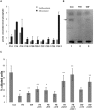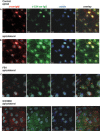Primary cilia in stem cells and neural progenitors are regulated by neutral sphingomyelinase 2 and ceramide
- PMID: 24694597
- PMCID: PMC4038499
- DOI: 10.1091/mbc.E13-12-0730
Primary cilia in stem cells and neural progenitors are regulated by neutral sphingomyelinase 2 and ceramide
Abstract
We show here that human embryonic stem (ES) and induced pluripotent stem cell-derived neuroprogenitors (NPs) develop primary cilia. Ciliogenesis depends on the sphingolipid ceramide and its interaction with atypical PKC (aPKC), both of which distribute to the primary cilium and the apicolateral cell membrane in NP rosettes. Neural differentiation of human ES cells to NPs is concurrent with a threefold elevation of ceramide-in particular, saturated, long-chain C16:0 ceramide (N-palmitoyl sphingosine) and nonsaturated, very long chain C24:1 ceramide (N-nervonoyl sphingosine). Decreasing ceramide levels by inhibiting ceramide synthase or neutral sphingomyelinase 2 leads to translocation of membrane-bound aPKC to the cytosol, concurrent with its activation and the phosphorylation of its substrate Aurora kinase A (AurA). Inhibition of aPKC, AurA, or a downstream target of AurA, HDAC6, restores ciliogenesis in ceramide-depleted cells. Of importance, addition of exogenous C24:1 ceramide reestablishes membrane association of aPKC, restores primary cilia, and accelerates neural process formation. Taken together, these results suggest that ceramide prevents activation of HDAC6 by cytosolic aPKC and AurA, which promotes acetylation of tubulin in primary cilia and, potentially, neural processes. This is the first report on the critical role of ceramide generated by nSMase2 in stem cell ciliogenesis and differentiation.
© 2014 He et al. This article is distributed by The American Society for Cell Biology under license from the author(s). Two months after publication it is available to the public under an Attribution–Noncommercial–Share Alike 3.0 Unported Creative Commons License (http://creativecommons.org/licenses/by-nc-sa/3.0).
Figures







Similar articles
-
Characterization of an apical ceramide-enriched compartment regulating ciliogenesis.Mol Biol Cell. 2012 Aug;23(16):3156-66. doi: 10.1091/mbc.E12-02-0079. Epub 2012 Jun 20. Mol Biol Cell. 2012. PMID: 22718902 Free PMC article.
-
Regulation of neural progenitor cell motility by ceramide and potential implications for mouse brain development.J Neurochem. 2008 Jul;106(2):718-33. doi: 10.1111/j.1471-4159.2008.05451.x. Epub 2008 May 2. J Neurochem. 2008. PMID: 18466329 Free PMC article.
-
Regulation of primary cilia formation by ceramide.J Lipid Res. 2009 Oct;50(10):2103-10. doi: 10.1194/jlr.M900097-JLR200. Epub 2009 Apr 16. J Lipid Res. 2009. PMID: 19372594 Free PMC article.
-
Ceramide formation as a target in beta-cell survival and function.Expert Opin Ther Targets. 2011 Sep;15(9):1061-71. doi: 10.1517/14728222.2011.588209. Epub 2011 Jun 2. Expert Opin Ther Targets. 2011. PMID: 21635197 Review.
-
Effects of ceramide and other simple sphingolipids on membrane lateral structure.Biochim Biophys Acta. 2009 Jan;1788(1):169-77. doi: 10.1016/j.bbamem.2008.09.002. Epub 2008 Sep 20. Biochim Biophys Acta. 2009. PMID: 18848519 Review.
Cited by
-
Aberrant Lipid Metabolism and Complement Activation in Age-Related Macular Degeneration.Invest Ophthalmol Vis Sci. 2024 Oct 1;65(12):20. doi: 10.1167/iovs.65.12.20. Invest Ophthalmol Vis Sci. 2024. PMID: 39405051 Free PMC article. Review.
-
Extracellular vesicles in β cell biology: Role of lipids in vesicle biogenesis, cargo, and intercellular signaling.Mol Metab. 2022 Sep;63:101545. doi: 10.1016/j.molmet.2022.101545. Epub 2022 Jul 8. Mol Metab. 2022. PMID: 35817393 Free PMC article. Review.
-
Lineage specificity of primary cilia in the mouse embryo.Nat Cell Biol. 2015 Feb;17(2):113-22. doi: 10.1038/ncb3091. Epub 2015 Jan 19. Nat Cell Biol. 2015. PMID: 25599390 Free PMC article.
-
Visualizing bioactive ceramides.Chem Phys Lipids. 2018 Nov;216:142-151. doi: 10.1016/j.chemphyslip.2018.09.013. Epub 2018 Sep 25. Chem Phys Lipids. 2018. PMID: 30266560 Free PMC article. Review.
-
A reduction of primary cilia but not hedgehog signaling disrupts morphogenesis in testicular organoids.Cell Tissue Res. 2020 Apr;380(1):191-200. doi: 10.1007/s00441-019-03121-8. Epub 2020 Jan 3. Cell Tissue Res. 2020. PMID: 31900662 Free PMC article.
References
-
- Aubin I, et al. A deletion in the gene encoding sphingomyelin phosphodiesterase 3 (Smpd3) results in osteogenesis and dentinogenesis imperfecta in the mouse. Nat Genet. 2005;37:803–805. - PubMed
-
- Bieberich E, Kawaguchi T, Yu RK. N-acylated serinol is a novel ceramide mimic inducing apoptosis in neuroblastoma cells. J Biol Chem. 2000;275:177–181. - PubMed
Publication types
MeSH terms
Substances
Grants and funding
LinkOut - more resources
Full Text Sources
Other Literature Sources
Research Materials
Miscellaneous

